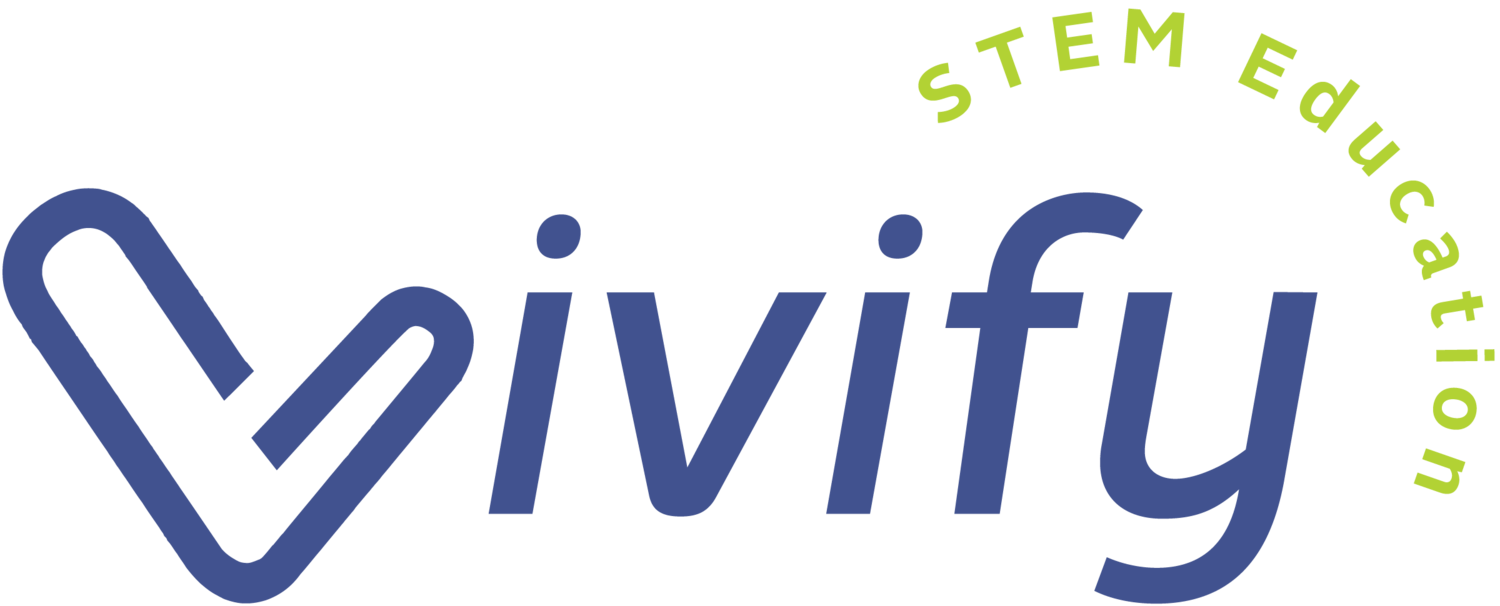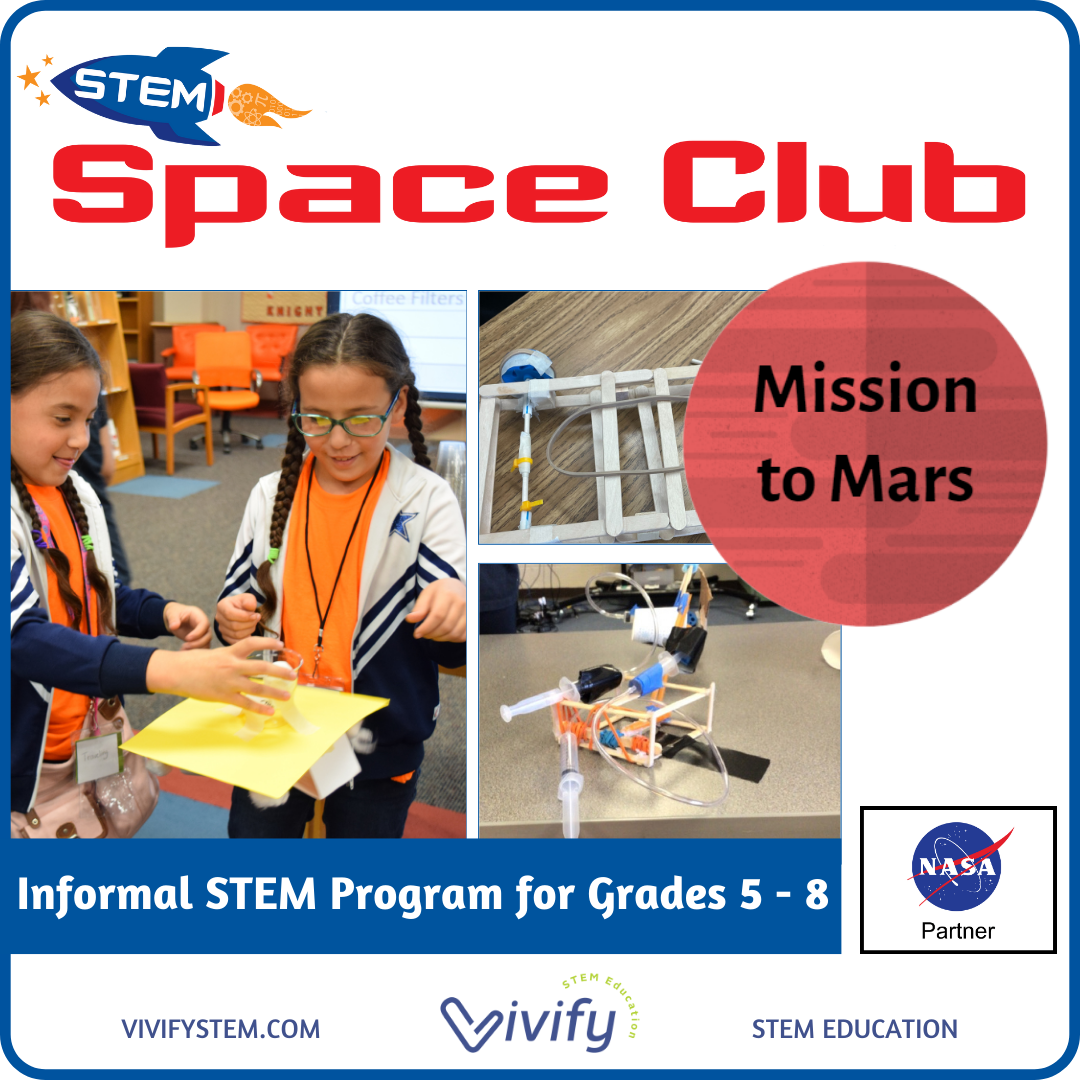Go on a Mission to Mars!
An inside look into Space Club’s Mission to Mars
Post by Michelle Bogden
Originally Posted: January 19, 2022
Updated: April 2025
I am a science teacher for grades 5-8, and last fall, my students went on an epic adventure as we tested out Space Club’s Mission to Mars curriculum! Read below for our experience and two space-themed engineering design challenges you can try in your classroom!
What is Space Club’s Mission to Mars?
I have always done engineering challenges with my students, but after learning about the 3 stages of STEM I wondered, was I ever taking my students further than stage 2? I would try various design challenges throughout the year, but I felt that they needed more. My goal as a teacher is to enrich students with the essential structure of the discipline. What does it really mean to be a scientist or engineer? How can I help students find success and autonomy in the subject?
Enter Mission to Mars! This was the chance to integrate engineering and science in a sequence of activities that were relevant, current, and real. Space Club is an FREE engineering curriculum that is being used by educators around the world! Download from our STEM Explorer Library!
Elementary and middle school students watch instructional videos led by a team of engineers, complete design challenges, join live Space Club Career Chats, and have the chance to win cool prizes!
When beginning, I felt a sense of ease and support through the professional development. I was able to watch detailed instructional videos, learn from real teachers, see student examples, and join a growing, positive learning community. Mission to Mars begins with Stage 1 team challenges that build teamwork and communication skills. Students are then guided through Stage 2 engineering design activities, and each unit is a progressively more complex design challenge as students arrive at and explore Mars. Seven missions lead the students to the eighth culminating challenge of designing and building a habitat on Mars. Here is an outline:
Meet the Crew - Team Challenges + Mission Patch + Hype Video
Get to Mars - Straw Rocket Engineering Challenge
Land on Mars - Landing Device Engineering Challenge
Explore the Surface - Wearable Device Engineering Challenge
Live from Mars - Video Report of Life on Mars
Collect Samples on Mars- Pneumatic Device Engineering Challenge
Transport Samples on Mars - Rover Engineering Challenge
Design & Build Mars Habitat
Free Space Club curriclum!
Implementing Space Club
Once familiar with the curriculum It was time to dive in! I implemented the activities during a block period 3 times a week for 90 min each. I had 15 students in the class and grouped them into teams of 3. Each mission took around 2-3 class periods. This could have been expanded even more with the plethora of supplemental activities and curriculum provided. I love how flexible the curriculum is to adapt to different learning environments!
When running each mission, my class spent the first-day gathering background information, brainstorming with teammates, and developing designs or plans. The second day was designated for building, testing, and reflecting. Sometimes the building would get extended into a third day. The class period flew by because of the different modes of learning, from warm-up discussions to readings, videos, designing, collaboration, etc.
Below is a look at two of the activities from Mission to Mars.
My Favorite Mission
If I had to pick a favorite, I would say Mission 6, designing a pneumatic device to collect soil samples on Mars! This is a unique challenge because pneumatics is a new concept to many students so they were very curious to learn more! By introducing pneumatics through bicycle pumps, students were able to see the real-life connections of pneumatics, making it understandable and relatable. Check out this video of pneumatics and how it can be a tool for means of transportation!
When tackling the engineering design challenge, the students initially had some difficulties, but it was definitely doable, and they felt accomplished and successful. I enjoyed seeing the different ways groups worked together and the diversity of designs they created. It was perfect preparation for Mission 7!
I talked with my students after the challenge, and here are some of their reflections:
"I think what I enjoyed most about this challenge was our starting device only being able to lift the sample 2 inches to our final device being about to lift the sample 9 inches."
This mission was a little challenging being it was something entirely new, so I struggled a little to understand how pneumatics worked. Yet eventually I started to get the gist, and I was much more comfortable!
Want to try this challenge with your students? Check out the Mission to Mars intro video below, and click the bubbles for the lesson plan. Here are the materials that I used with my students:
1 Ping pong ball
20 Craft sticks
2 Rubber bands
2 Bendy straws
2 Pipecleaners
Most Challenging Mission
Mission 7, designing a rover to transport a rock sample, was definitely a challenge for my students. But I think that's why it's mission 7! The teams had worked through so many obstacles to get to that point that they were ready for it.
I allowed students to make the rovers without giving too many restrictions. This resulted in some teams trying out several different designs, and this took a lot of time. The most successful groups took one design and stuck to it, continuing to make changes and improvements as needed. The students also needed to figure out how to create enough traction on the wheels to propel the car forward.
But, by the end, the class felt a sense of accomplishment and was beaming with pride! This challenge took 3 sessions to complete but by the end each team had success. Here are the materials we ended up using:
12 Craft sticks
2 7 inch Rubber bands
3 5 inch Rubber bands
2 Zip ties
2 Straws
4 Wheels (Wheel & Axle set)
4 Wooden dowels
1 Hot glue gun (recommended) or Elmer’s glue
Masking tape
Scissors
Cup
To try this mission with your students, check out the intro video and find the full lesson plan below!
What did my students learn?
A mix of engineering design, science, careers, and intrinsic motivation are the results of this experience. Students were familiar with building challenges but often only in a short period and didn't expand much further. This opportunity helped them dive further into design and how engineers think. They also learned science concepts featuring Mars, circuits, pneumatic devices, how rockets fly, and many more! Careers were mentioned in the reading and often followed up with a video. One of the career videos about biomedical engineering was actually only 20 min away from us and the kids really thought that was cool to see these STEM careers so close to home. We also incorporated the career chats during indoor lunchtime! The intrinsic motivation or agency from the students was incredible. I even had absent students emailing asking how they would make their work or nervous they were missing out.
Want to try Mission to Mars? Here is my advice.
Following the progression of the missions is a key element of the program. Continuation from Mission 1 - Mission 8 helps students be successful with some of the more challenging tasks. It also connects content in a logical format.
Take time to get organized and be flexible. It's a dynamic learning process for you and the students.
Just try it! Do not let the size of the content or new challenges overwhelm you. Students are resilient and creative and the reward of seeing their success is enriching. I am much more confident now on some of these challenging tasks like the rubber band car. It was a new experience for me and my students and we worked together to be successful. Trying new curriculum makes you feel good!
Space Club will be a lasting memory for my students. They couldn't wait to come to science to see what type of mission we would explore. I am eager to implement Space Club again and excited to see how I can continue to develop the program further!





